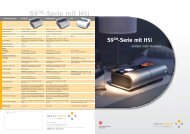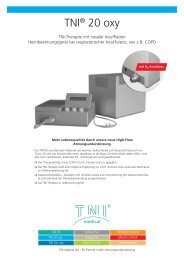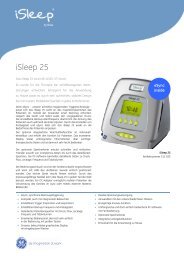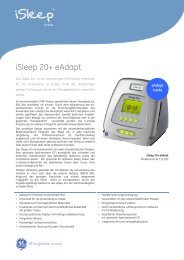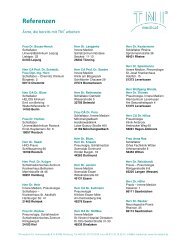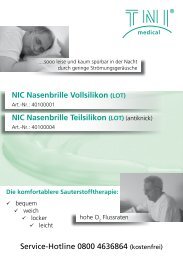Download Product catalogue - TNI medical AG
Download Product catalogue - TNI medical AG
Download Product catalogue - TNI medical AG
Create successful ePaper yourself
Turn your PDF publications into a flip-book with our unique Google optimized e-Paper software.
<strong>TNI</strong> ® Studies<br />
Correct Citation for publication:<br />
Therapy<br />
Diagnostics<br />
Treatment of Sleep-Disordered Breathing in Chronic Obstructive Pulmonary Disease with Nocturnal<br />
Nasal Insufflation. C.D. Brown, M.D., L.B. Herpel, M.D., K.L. Goring, M.D., P.L. Smith, M.D., R.A. Wise,<br />
M.D., H. Schneider, M.D., Ph, A.R. Schwartz. Proc Am Thor Soc 2007,, A709<br />
Poster Board #F64] Treatment of Sleep-Disordered Breathing in Chronic Obstructive Pulmonary<br />
Disease with Nocturnal Nasal Insufflation, [Publication Page: A709]<br />
C.D. Brown, M.D., L.B. Herpel, M.D., K.L. Goring, M.D., P.L. Smith, M.D., R.A. Wise, M.D., H. Schneider,<br />
M.D., Ph, A.R. Schwartz, M.D., Baltimore, MD<br />
Introduction: Sleep-disordered breathing (SDB) with inspiratory flow limitation (IFL) is common in patients<br />
with COPD, even without frank apneas or hypopneas. Nocturnal nasal insufflation (NNI) may relieve IFL and<br />
upper airway obstruction during sleep to improve gas exchange and sleep quality in COPD.<br />
Methods: Non-hypoxemic individuals with a wide range of COPD severity underwent baseline<br />
polysomnography to determine the severity of sleep-disordered breathing. On a separate night, subjects<br />
were exposed to alternating trials of NNI (20 L/min), oxygen (2 L/min), and room air during NREM sleep.<br />
SDB indices including arousal-terminated IFL event rates, the apnea-hypopnea index (AHI) and<br />
transcutaneous carbon dioxide (TcCO2) were compared among conditions.<br />
Results: NNI decreased the arousal frequency, AHI, and TcCO2 from the room air and oxygen conditions.<br />
NNI resulted in a 50% reduction in IFL events compared to room air (p=0.04) whereas oxygen was<br />
associated with a 120% increase in IFL events. TcCO2 increased during oxygen treatment and fell during<br />
NNI compared to the room air condition (Figure 1, p=0.001 for NNI vs. room air).<br />
Conclusion: NNI decreased SDB and improved nocturnal ventilation in patients with COPD. The CO2<br />
response to NNI suggests that IFL contributes to the development of nocturnal hypoventilation in COPD and<br />
that NNI may constitute a novel treatment for SDB in COPD.<br />
21




